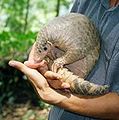- Indian Pangolin
-
Indian Pangolin[1] 
Conservation status Scientific classification Kingdom: Animalia Phylum: Chordata Class: Mammalia Order: Pholidota Family: Manidae Genus: Manis Species: M. crassicaudata Binomial name Manis crassicaudata
Gray, 1827
The Indian Pangolin (Manis crassicaudata) or ”Scaly Ant-eater” is a pangolin that is found in the plains and hills of India, Sri Lanka and some parts of Pakistan. It is not common anywhere in its range. Like other pangolins, it has large, overlapping scales on the body which act like an armour. It can also curl itself into a ball as self defense against predators such as the tiger. Its colour of its scales varies and depends on the colour of the earth in its surroundings.[3] It is an insectivore that feeds on ants and termites, digging them out of mounds and tree-logs using its long claws, which are as long as its forelimbs. It is nocturnal and rests in deep burrows during the day.
It is hunted for its meat, which is considered tasty, and for making medicinal oil.[4]
In Kerala, it is known as "Eenampechi". In Sinhala it is called ”Kaballewa” and in Tamil ”Azhungu” or "Alangu" [5]
Pictures
References
- ^ Schlitter, Duane A. (16 November 2005). "Order Pholidota (pp. 530-531)". In Wilson, Don E., and Reeder, DeeAnn M., eds. Mammal Species of the World: A Taxonomic and Geographic Reference (3rd ed.). Baltimore: Johns Hopkins University Press, 2 vols. (2142 pp.). p. 530. ISBN 978-0-8018-8221-0. OCLC 62265494. http://www.bucknell.edu/msw3/browse.asp?id=13900009.
- ^ Pangolin Specialist Group (1996). Manis crassicaudata. 2006. IUCN Red List of Threatened Species. IUCN 2006. www.iucnredlist.org. Retrieved on 11 May 2006.
- ^ ”Pangolins And Porcupines” by Jayantha Jayawardene, ”Daily News”, 21 August 2006. http://www.angelfire.com/planet/wildlifesl/articles/dn_pangolins_porcupines.htm (Retrieved on 4-6-2011).
- ^ ”Pangolin Or Scaly Ant Eater (Manis carssicaudata)” by Dr. Susan Sharma. http://www.indianwildlifeclub.com/ezine/view/details.aspx?aid=234 (Retrieved on 4-6-2011).
- ^ Prater, S. H. 1971. The Book of Indian Animals (Third Edition). Bombay, India: Bombay Natural History Society. ISBN 0195621697
Extant Pholidota (Pangolins) species Kingdom: Animalia · Phylum: Chordata · Class: Mammalia · Infraclass: Eutheria · Superorder: LaurasiatheriaManis Subgenus Manis: Indian Pangolin (M. crassicaudata) · Chinese Pangolin (M. pentadactyla)
Subgenus Paramanis: Philippine Pangolin (M. culionensis) · Sunda Pangolin (M. javanica)
Subgenus Smutsia: Giant Pangolin (M. gigantea) · Ground Pangolin (M. temmincki)
Subgenus Phataginus: Tree Pangolin (M. tricuspis)
Subgenus Uromanis: Long-tailed Pangolin (M. tetradactyla)Category
This article about a mammal is a stub. You can help Wikipedia by expanding it.







